Genre et inclusion
Au fur et à mesure que les transferts monétaires continuent à se développer, les parties prenantes demandent une meilleure prise en compte des problématiques de genre et d’inclusion car « des transferts monétaires sensibles au genre qui tiennent compte des disparités et répondent équitablement aux besoins de toutes les personnes affectées par une crise ont le potentiel d’avoir un impact positif sur les femmes et les filles en les protégeant davantage et en favorisant leur autonomisation, tout en renforçant les impacts spécifiques au secteur, qui peuvent rendre les ménages et les communautés ayant vécu une crise plus résilient·es et plus autonomes. » (Directives pour le chantier du Grand Bargain sur les transferts monétaires et le genre). La pandémie de COVID-19 a accru l’urgence de l’assistance car elle a affecté les femmes et les groupes exclus en particulier en augmentant la charge de travail de soin, en réduisant les opportunités d’emploi de manière disproportionnée et en exposant les femmes à des difficultés financières plus fortes et à davantage de violences basées sur le genre.
Le CALP Network continue d’ancrer son travail sur le symposium #GenreEtTransfertsMonétaires organisé en 2018 à Nairobi et sur l’engagement inscrit dans le programme pour l’action collective (Agenda for Collective Action) qui en a résulté. Le rapport « La situation mondiale des transferts monétaires en 2020 » fait état de progrès notables en matière de genre et de transferts monétaires, alors que ce domaine était marqué par des lacunes importantes en matière de données probantes dans le dernier rapport. De nouvelles directives ont été produites sur le genre et les transferts monétaires, ainsi que le genre et les VBG, et des efforts ont été réalisés en termes de synthèse et d’identification de données probantes plus rigoureuses. L’attention, portée initialement aux VBG, s’oriente désormais vers l’égalité entre les genres et l’adaptation de la programmation afin qu’elle ne tienne plus seulement compte du genre mais intègre cette problématique de manière transversale, et même transformatrice. Toutefois, bien que nous remarquions des progrès au niveau technique partout dans le monde, cela ne s’est pas traduit par des changements ancrés en termes de planification, de mise en œuvre et de suivi.
Priorités actuelles
Nous continuerons à travailler étroitement avec les responsables du chantier auxiliaire du Grand Bargain sur les transferts monétaires, CARE et ONU Femmes pour mettre en œuvre le plan de travail. Le CALP Network va continuer à encourager les acteurs de l’assistance monétaire à prendre en compte davantage de problématiques afin d’être plus inclusifs, et de favoriser une meilleure compréhension de la manière dont nous pourrions utiliser les transferts monétaires pour ne pas nous contenter de ne pas nuire mais aussi lutter contre ces inégalités socio-économiques par le biais de la prestation d’autres services et modalités de soutien.
Contenu associé

Collected Papers on Gender and Cash Transfer Programmes in Humanitarian Contexts
Report
Existing gender inequalities mean that disasters and conflicts impact women, men, girls and boys differently. Cash based assistance is one of the most significant developments in humanitarian assistance in recent years. But the relationship between gender and cash based assistance in humanitarian contexts is poorly understood. All too often, interventions are designed based on assumptions...

Guide for Protection in Cash based Interventions
Guidelines and Tools
This guide identifies minimum necessary information and key resources needed to help humanitarian practitioners ensure that protection risks and benefits are considered and monitored throughout the cash-based interventions (CBI) program cycle, using a community-based approach and participatory methods as much as possible. It can help to inform CBI in any program context: protection...

Microlearning video: CVA and Gender
Blog Post
This video provides an overview of the relationship between gender and cash and voucher assistance (CVA) structured around the humanitarian project cycle, which include: Assessment and response analysis: How to adjust the assessment processes to achieve a more accurate reflection of gender and markets. Design and implementation: How to use methods and protocols to reduce the potential...
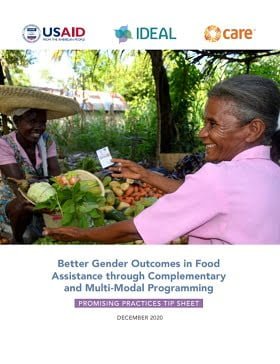
Better Gender Outcomes in Food Assistance through Complementary and Multi-Modal Programing: Promising Practices Tip Sheet
Guidelines and Tools
This Tip Sheet is excerpted from the research report, “Better Gender Outcomes in Food Assistance through Complementary and Multi-Modal programming,” and gives promising practices by the cycles of project cycle management, as well as at the response level. Additionally, there are expert tips and wisdom practices that support the use of a gendered approach in development or humanitarian...

Cash & Voucher Assistance and Gender-Based Violence Compendium
Guidelines and Tools
The Compendium is intended as a companion to the 2015 Inter-Agency Standing Committee (IASC) Guidelines for Integrating Gender-Based Violence Interventions in Humanitarian Action and its companion resource, the GBV Pocket Guide. The guidance was developed through the efforts of 15 organizations who contributed expertise in the inception, design and review of the document. The process was led...

Cash and Voucher Assistance that Works for Women: 6 lessons from the field
Report
Building on CARE’s commitment to be ‘cash ready’ to achieve breakthroughs with and for women and girl, CARE commissioned a study –in Malawi, Haiti, Jordan, the Philippines and Niger–on gender-sensitive CVA that allowed actual CVA recipients to frame the discussion. This is a brief from the research “What Does Gender-Sensitive Cash and Voucher Assistance Look Like?” and presents...
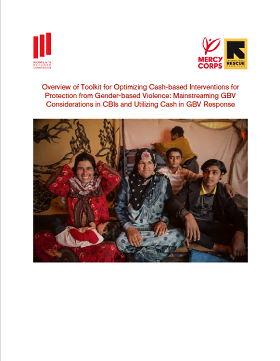
Toolkit for Optimizing Cash-based Interventions for Protection from Gender-based Violence
Guidelines and Tools
Efforts to prevent and respond to GBV should be a priority for all actors in all humanitarian response operations from the very start. By mainstreaming GBV considerations in CBIs throughout the program cycle and by utilizing cash within GBV case management services, cash can be optimized as a tool to enhance the protection of crisis- and conflict-affected populations and to mitigate risks of...
Thematic lead
Contenu récent
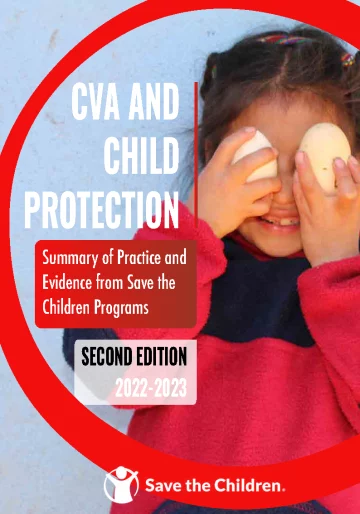
Cash and Vouchers Assistance (CVA) and Child Protection: Summary of practice and evidence from Save the Children programmes 2023 Edition
Report
In an effort to increase global knowledge and learning, Save the Children conducted a global review of twenty Country Offices and their programs in order to assess and highlight the impact that different forms of Cash and Vouchers Assistance (CVA) have on Child Protection (CP) outcomes, to identify...

Cash & Voucher Assistance (CVA) & Child Protection (CP) Global Study – Research Report in the DRC, Egypt, Lithuania and the Philippines
Report
Since 2022, Save the Children has been scaling up its use of CVA for Child Protection (CP) programming through various pilot projects.
Research was commissioned in four countries in 2022-23 to generate evidence and learning to inform the design of future programming but also to design a robust...

Locally Led Anticipatory Action Guide and Toolkit
Guidelines and Tools
How civil society organisations can engage with communities, and collaborate with mandated, technical and donor agencies to localise and scale up early warning and early action
The purpose of the guide is to support civil society organisations to engage with communities and other actors and structures...

Addressing Negative Socioeconomic Impacts of the COVID-19 Pandemic through Social Protection in Viet Nam – Supporting incomes and livelihoods with cash assistance in Dong Nai province
Case Study
In late April 2021, Viet Nam faced its fourth wave of COVID-19, with over 895 000 new cases reported. COVID-19 and related restrictions hindered livelihood options and vulnerable households faced financial stress to cover basic needs. Some of them lost their income and were unable to return to home...

Philippines Cash and Voucher Assistance (CVA) and Child Early and Forced Marriages and Unions (CEFMU): Program Summary and Evidence-Building Infographic
Case Study
This infographic gathers key programmatic data from Save the Children CVA operations in the Philippines between January and August 2023, which aimed to assess and highlight the impact that CVA has on child protection outcomes, with a specific focus on Child Early and Forced Marriages and Unions (CEFMU).

Just in Time: Advancing anticipatory cash in Pakistan
Guidelines and Tools
Cash and voucher assistance in humanitarian response has grown significantly in recent years, with evidence showing that it supports the agency of recipients, reduces harmful coping strategies, supports local economies, and is a cost-effective form of humanitarian assistance.
The use of cash as a form...

Impact Evaluation of Cash-Based Transfers on Food Security and Gender Equality in El Salvador
Case Study
1. Gender inequality is pervasive, particularly in developing countries such as El Salvador, and its potential welfare implications are concerning. In El Salvador, only 45.4 percent of women participate in the labour market, in contrast to 74.4 percent of men. 2. Economic development, gender equality in...

Will our Opinion Matter? Community consultations on the design of multi-purpose cash programmes in Lebanon
Report
Since late 2019, Lebanon has been grappling with a severe economic and financial crisis. The Lebanese lira has lost more than 98 percent of its value, and over half of the Lebanese population is estimated to be living in poverty. The Government of Lebanon and development and humanitarian agencies have...

Ensuring Inclusive Cash and Voucher Programming in Vanuatu
Report
Save the Children is expanding its cash and voucher programming in Vanuatu; helping families to overcome financial barriers to improve outcomes for their children and advocating for investments in a national social protection system.
This report presents the findings of a Gender Equality, Disability...
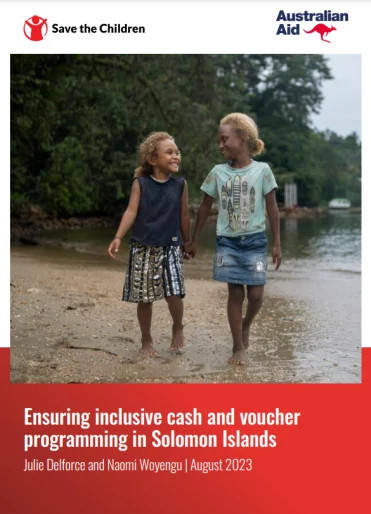
Ensuring Inclusive Cash and Voucher Programming in Solomon Islands
Report
Save the Children is expanding its cash and voucher programming in Solomon Islands; helping families to overcome financial barriers to improve outcomes for their children and advocating for investments in a national social protection system.
This report presents the findings of a Gender Equality,...
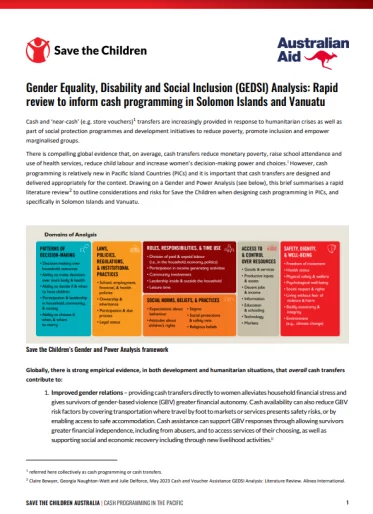
Gender Equality, Disability and Social Inclusion (GEDSI) Analysis: Rapid review to inform cash programming in Solomon Islands and Vanuatu
Report
There is compelling global evidence that, on average, cash transfers reduce monetary poverty, raise school attendance and use of health services, reduce child labour and increase women’s decision-making power and choices. Cash programming though, is relatively new in Pacific Island Countries (PICs) and...

Feasibility study on CVA in Tigray Region, Ethiopia_October 2023
Report
The two years of conflict in Tigray has fueled a large-scale humanitarian crisis and resulted in loss of livelihoods and widespread food insecurity of the population especially Internally Displaced Populations and agrarian communities in the region.
The crisis affected the livelihoods of the...

WVI Cash Roadmap 2.0 – New Avenues – Leveraging, multiplying “Nexus” cash to take children and their families further than imagined
Policy paper
WVI's strategic global Cash Roadmap 2.0 (2024-2027) speaks to the organisations' commitment that amidst polycrises and resourcing constraints, there is urgency to maximise and multiply World Vision's capabilities, assets and cash voucher programming (CVP=CVA) is a powerful tool to do so.
Increasing...

Gender-Transformative Social Protection in Crisis Contexts: Guidance note
Guidelines and Tools
This guidance note is produced under the Social Protection Technical Assistance (STAAR) facility which is funded by FCDO and implemented by DAI Global UK. It was commissioned by GiZ on behalf of the German Federal Ministry for Economic Cooperation and Development (BMZ) to advance the international...

Exploring GBV Risk Mitigation in Iraq and Colombia
Case Study
In 2022, UNFPA and the Global Women’s Institute (GWI) at George Washington University undertook operational research in Iraq and Colombia with the goal of developing proxy indicators for mitigating GBV risk to women who receive cash assistance. Proxy indicators for detecting GBV risks to women in cash...

What’s Next for Cash: Mercy Corps’ approach to cash and voucher assistance
Presentation
The brief outlines Mercy Corps' CVA approach & standards applied across our CVA portfolio and sets the direction for CVA in Mercy Corps moving forward.
The approach outlines how CVA contributes to Mercy Corps Pathway to Possibility strategy by focusing on areas that drive impact & sector leadership,...

Building Capital in Crisis: How women in CARE’s VSLAs in Emergencies increase savings and solidarity
Report
Since 2017, CARE has piloted and refined our VSLA in Emergencies model to reach people in need of humanitarian assistance and provide an approach that can reduce long term vulnerability while being more sustainable. In this second report on our pilot research, we provide insights from three pilots in...

Humanitarian Cash Transfers and Intimate Partner Violence in South Sudan
Case Study
Cash-based programming, an intervention commonly provided to people affected by humanitarian crisis, has the potential to affect IPV positively or negatively. This study, however, found no evidence that this cash-based project had any significant effect on IPV. However, the relationship between cash...

“Men have the power to say everything, women don’t.” Women’s perceptions of cash and voucher assistance in Maiduguri’s outskirts
Case Study
In northeast Nigeria, women and girls constitute approximately two-thirds of cash and voucher assistance (CVA) recipients. However, stark gender inequalities in the region make it difficult to hear women’s perspectives. This study aims to amplify their voices and concerns to inform decision-making...

Impact Evaluation of Cash-Based Transfers and Gender in Kenya: Inception report
Guidelines and Tools
Gender inequality in economic autonomy is pervasive, particularly in developing countries, and its potential welfare implications are concerning. The World Economic Forum’s (WEF) Global Gender Gap Report for 2022 ranks Kenya as 57th for the Gender Gap on Economic participation, and an opportunity index...




